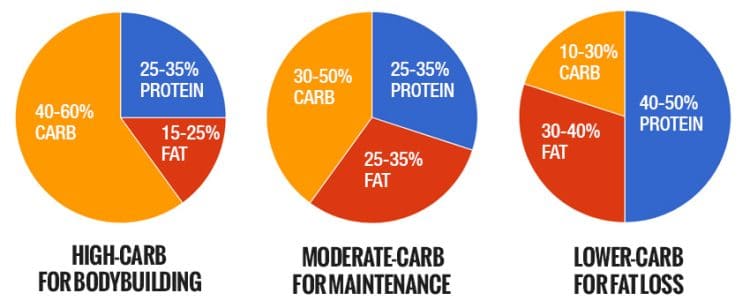Gym-lore states that you need to eat more food if you want to gain weight. Conversely, to lose weight or burn fat, you need to eat less. And while these instructions are not incorrect, they are pretty vague. Eating more or eating less is no guarantee of success as the amount of food you consume is crucial.
A lot of diets specify meal size and are designed to provide a set number of calories per day, such as 1,500 or 3,000.
However, depending on your goals, genetics, and the amount of exercise and physical activity you do per day, such generalized diets may not be appropriate. For example, they could provide too many or too few calories.
For best results, you need to know how many calories your body burns per day. That way, you can make precise adjustments to build muscle or burn fat.
Use our Active Metabolic Rate calculator to determine your estimated daily calorie requirements.
AMR Calculator
[sc name=”amr-cal”][/sc]
What is AMR?
Fitness and nutrition experts love their abbreviations. Hearing two fitness people talking is like listening to a conversation in code! Knowing what these abbreviations mean will make learning about fitness, exercise, training, and nutrition much easier.
So, AMR is short for Active Metabolic Rate. In simple terms, your AMR is the number of calories you burn in 24 hours, including an allowance for exercise.
Your AMR includes the energy you use to power metabolic functions, like breathing, pumping blood around your body, brain function, etc., as well as planned and unplanned physical activity.
Your daily calorie expenditure without accounting for exercise is called your Basal Metabolic Rate, or BMR for short. You can estimate your BMR using this calculator.
How is AMR Calculated?
Our AMR calculator uses two equations to determine your Active Metabolic Rate. The two equations are:
1. Mifflin St. Jeor Equation
- Men: 10 x weight (kg) + 6.25 x height (cm) – 5 x age (y) + 5
- Women: 10 x weight (kg) + 6.25 x height (cm) – 5 x age (y) – 161
2. Revised Harris-Benedict Equation
- Men: (13.397m + 4.799h – 5.677a) + 88.362
- Women: (9.247m + 3.098h – 4.330a) + 447.593
(m is mass in kg, h is height in cm, a is age in years)
Each of these calculations reveals your BMR or Basal Metabolic Rate. Once BMR is determined, the calculator then estimates your AMR by multiplying that number by the appropriate activity factor:
- Sedentary = BMR x 1.2 (little or no exercise, desk job)
- Lightly active = BMR x 1.375 (light exercise or sports 1-3 days per week)
- Moderately active = BMR x 1.55 (moderate exercise or sports 6-7 days per week)
- Very active = BMR x 1.725 (hard exercise every day, or exercising twice a day)
- Extra active = BMR x 1.9 (hard exercise two or more times per day, or training for a marathon, triathlon, etc.
[sc name=”style-blue-box” ]
While you COULD work all this out by hand, you don’t need to. Our AMR calculator does all the heavy lifting for you, so you don’t have to strain your brain!
[/sc]
How To Use The AMR Calculator
Our AMR calculator is incredibly easy to use. Just follow these step-by-step instructions, and you’ll have your results in seconds…
- Choose between imperial units (pounds, feet, and inches) or metric units (kilograms, meters, and centimeters)
- Specify your gender
- Enter your weight
- Enter your height in feet/meters and inches/centimeters
- Specify your current activity level
- Hit “Calculate”
Your results should appear almost instantly. If any of the boxes are outlined in red, this means you have either not entered a workable value or have not provided all the information needed. Go back and enter the required details, and the calculator will work correctly.
What Do the Results Mean?
Your AMR is the number of calories your body uses per day, including exercise. It’s calculated by multiplying your Basal Metabolic Rate by the appropriate activity factor.
If, for example, your AMR is 2,450 calories, that means your body uses that amount of energy per day. Consuming 2,450 calories should mean that your body weight remains relatively constant, and you won’t gain or lose body fat.
Factors that may affect your AMR include:
- Muscle mass – the more muscular you are, the more calories your body uses at rest. Gaining muscle is one of the best ways to increase your AMR.
- Age – AMR tends to decline with age, often because of decreases in muscle mass. Lost muscle is one of the factors that lead to middle-age weight gain.
- Genetics – some people have a higher AMR than others and are said to have a “fast metabolism.”
- Weather – cold weather tends to increase AMR as your body will have to use more energy to maintain its core temperature. Being very hot also burns more calories, as your body needs to expend energy to try and keep you cool.
- Pregnancy – being pregnant causes an increase in AMR as more energy is required by the growing fetus. Menopause also affects AMR and can cause it to increase or decrease depending on hormonal changes.
- Supplements and drugs – stimulants can cause AMR to increase, including caffeine. Other medications can cause the AMR to fall, such as some sedatives.
- Activity levels – as AMR includes calories burned during exercise, the more physical activity, the higher the value will be. Conversely, if you do less physical activity, your ARM will be lower. As such, you should adjust your food intake according to the amount of activity on a given day. For example, you may choose to eat less on a rest day.
How to Use Your AMR?

Once you know your AMR, you can use it to determine how many calories you should consume per day to achieve your weight and body composition goals.
To get leaner and lose weight, you need to lower your calorie intake to 300-500 below your AMR. This will create a calorie deficit or negative energy balance, forcing your body to burn stored body fat for fuel. This reduction in calories should mean that you lose 1-2 pounds per week.
To build muscle and gain weight, you need to increase your calorie intake by 500 calories above your AMR. This will create a calorie surplus or positive energy balance. Your body will use these extra calories for workout recovery and muscle growth.
[sc name=”style-blue-box2″ ]
Note: these calorie recommendations are only guidelines. You may need to raise or lower them depending on your progress.
[/sc]
Tracking Your Calorie Intake
If you’ve taken the time to calculate your Active Metabolic Rate, you also need to track your food intake to ensure you are consuming the correct number of calories for your goal, i.e.:
- Equal to your AMR to MAINTAIN your current weight
- 300-500 less than your AMR to LOSE weight and burn fat
- 500 more than your AMR to GAIN weight and build muscle
The easiest way to track your food intake is to use an app on your phone or tablet. There are simple, free food trackers as well as paid versions that are packed with features, such as variable macros, goal setting, in-depth nutritional breakdowns, and even customizable eating plans.
Alternatively, you can just use an online food database and work everything out for yourself.
While weighing and measuring your food can be time-consuming at first, it does get easier because most people eat the same meals several times a week. So, for example, you might have the same breakfast every day. While working out the calories in a new meal is a little laborious, so long as you save the information, you won’t have to calculate it again.
What About Macros?
The calories in your food come from a combination of proteins, carbohydrates, and fats. These good groups are collectively called the macronutrients, or macros for short. Macro means big.
While all three macros are important, changing the amount you eat of each one may help you achieve your body composition goal faster.
For example, cutting carbs and eating more protein may speed up fat loss (1). In contrast, building muscle is usually easier if you consume an abundance of protein.
So, once you know your AMR, you should then determine how many calories of proteins, carbohydrates, and fats you need to eat for the best results.
Options include:

Use our Macro Calculator to determine the best macro ratio for your training goals.
[sc name=”calorie-cal” ][/sc]
AMR FAQs
What does AMR mean?
AMR is short for Active Metabolic Rate. It’s the amount of energy your body uses per day in calories, including what’s needed for physical activity and exercise. It’s your BMR (Basal Metabolic Rate) multiplied by an appropriate activity factor. The more active you are, the higher your AMR will be.
How Accurate is the AMR calculator?
This calculator uses two proven equations to estimate your AMR; Mifflin St. Jeor, and Revised Harris-Benedict. In studies, these equations have been shown to be accurate to within 10% (2).
As such, you should monitor your progress and adjust your calorie intake based on your individual results. The only completely accurate way to determine AMR is in a laboratory.
How often do I need to recalculate my AMR?
Your AMR will change if you gain muscle. It’s estimated that adding one pound of muscle to your body will increase AMR by around 50 calories per day (3). AMR also declines with age. As such, you will need to recalculate AMR from time to time.
However, changes in your AMR happen relatively slowly, so there is no need to recalculate it daily or weekly. Instead, use our AMR calculator every month or two and adjust your calorie intake based on your most recent results.
How many calories should I eat per day?
Your ideal calorie intake depends on your body composition goal:
- Maintain your current weight by consuming the same number of calories as your AMR.
- To burn fat, subtract 300-500 calories from your AMR to create a calorie deficit.
- To gain weight or build muscle, add 500 calories to your AMR to create a calorie surplus.
Wrapping Up
You are what you eat, or so the old saying goes. And while that’s 100 percent true, you are also how MUCH you eat! After all, your body needs calories as well as protein, carbohydrates, fats, fiber, vitamins, and minerals. Calories are energy.
Your calorie intake needs to reflect both your needs and your goals. Consume too many, and you may gain fat or struggle to lose weight. But, consume too few, and you could undermine your workouts and struggle to build muscle.
Use our Active Metabolic Rate calculator to determine how many calories your body needs per day, and adjust your intake according to your workout and fitness goals.
References:
1- PubMed: A high-protein diet for reducing body fat: mechanisms and possible caveats https://www.ncbi.nlm.nih.gov/pmc/articles/PMC4258944/
2- PubMed: Comparison of predictive equations for resting metabolic rate in healthy non-obese and obese adults: a systematic review https://pubmed.ncbi.nlm.nih.gov/15883556/
3- PubMed: Effects of exercise intensity and duration on the excess post-exercise oxygen consumption https://pubmed.ncbi.nlm.nih.gov/17101527/


